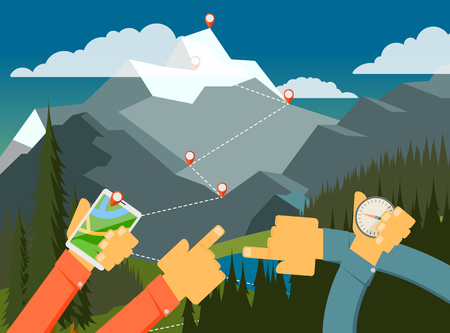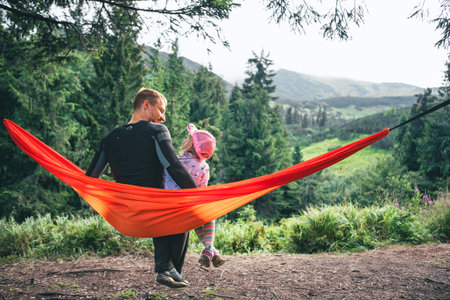Introduction to Long-Distance Hiking Backpacks
When it comes to long hiking trips across the United States—whether you’re trekking through the Appalachian Trail, exploring the Rockies, or venturing into the Pacific Northwest—you need a backpack that’s built for serious mileage. A great camping backpack isn’t just about size; it’s about smart design and comfort that lasts for days on the trail.
Let’s take a closer look at what makes a backpack ideal for extended hiking adventures:
Key Features of a Great Long-Hike Backpack
| Feature | Description |
|---|---|
| Comfort | Padded shoulder straps, adjustable hip belts, and breathable back panels help reduce fatigue over long distances. |
| Capacity | A good pack should hold between 50–70 liters for multi-day hikes, giving you enough space for gear, food, and clothing. |
| Durability | Tough materials like ripstop nylon or Cordura fabric withstand rough terrain, unpredictable weather, and heavy use. |
| Weight Distribution | An internal frame and load-lifting straps help evenly distribute weight to avoid strain on your back and shoulders. |
Why These Features Matter in the U.S.
The diverse terrain in the U.S.—from desert heat in Arizona to high-altitude chill in Colorado—demands gear that can adapt. You’ll often be far from civilization, so your backpack needs to handle both comfort and function without fail. Whether youre thru-hiking or spending just a few nights in national parks, having the right backpack makes all the difference between an enjoyable adventure and a miserable one.
A Backpack That Works With You
Your backpack should feel like part of your body—not something you’re constantly adjusting or struggling with. That’s why choosing a pack with customizable fits and thoughtful organization is key. In upcoming sections, we’ll highlight our top picks that deliver on all these fronts and more.
2. Key Factors to Consider When Choosing a Backpack
When youre planning a long hiking trip in the U.S., choosing the right camping backpack can make or break your adventure. From tackling rugged mountain trails to navigating humid forests or dry desert paths, the conditions vary widely across the country. Here are the most important features to keep in mind when picking your ideal pack.
Torso Fit and Sizing
One of the first things to consider is how well a backpack fits your body, especially your torso length. A poorly fitted pack can cause back pain and fatigue over time.
| Torso Length (inches) | Backpack Size |
|---|---|
| 15″ or less | Extra Small |
| 16″ – 17″ | Small |
| 18″ – 19″ | Medium |
| 20″ or more | Large |
Load Support and Weight Distribution
For long-distance hikes, especially those with elevation gains like in the Rockies or Appalachians, youll want a backpack with strong load support. Look for packs with internal frames, padded hip belts, and adjustable suspension systems. These features help distribute weight evenly across your hips and shoulders, reducing strain on your back.
Ventilation and Comfort
If you’re hiking in warmer regions like Arizona or Southern California, airflow is crucial. Many modern backpacks feature mesh panels and suspended back designs to promote ventilation. This helps reduce sweating and keeps you more comfortable during hot days on the trail.
Gear Accessibility
You don’t want to unpack everything just to grab your rain jacket or snacks. Choose a backpack with multiple access points—like top-loading openings, side zippers, and front stash pockets. Some even come with dedicated sleeping bag compartments for better organization.
Pocket Types You Might Find Useful:
- Hip Belt Pockets: Great for quick-access items like lip balm or energy bars.
- Side Stretch Pockets: Perfect for water bottles or trekking poles.
- Lid Pockets: Handy for maps, headlamps, or sunglasses.
Weather Resistance
The U.S. has diverse climates—from wet Pacific Northwest trails to sudden downpours in the Smoky Mountains. A water-resistant backpack is essential. Many top hiking packs come with built-in rain covers or are made from treated fabrics that repel water. Be sure to check if seams are sealed and zippers are weather-protected too.
Quick Tip:
If your pack doesn’t include a rain cover, it’s worth buying one separately—especially if you plan on hiking in variable weather zones.
Selecting a backpack with these key features will help ensure that you stay comfortable and organized throughout your journey, no matter where your U.S. hiking adventure takes you.

3. Top Brands and Innovation in U.S. Outdoor Gear
When it comes to choosing a camping backpack for long hiking trips in the U.S., knowing which brands are trusted and what innovations they offer can make a big difference. Over the years, several outdoor gear companies have established themselves as leaders in the American market by consistently producing high-quality, durable, and comfortable backpacks designed for extended adventures.
Trusted Backpack Brands in the U.S.
These are some of the most reliable backpack manufacturers that hikers across the country trust:
| Brand | Known For | Popular Model |
|---|---|---|
| Osprey | Comfortable fit, advanced suspension systems | Osprey Atmos AG 65 |
| Deuter | Durability and ventilation technology | Deuter Aircontact Lite 65+10 |
| Gregory | Ergonomic designs and load distribution | Gregory Baltoro 75 |
| REI Co-op | Affordable quality with great features | REI Co-op Traverse 70 |
| Hyperlite Mountain Gear | Ultralight and minimalist design | Hyperlite Southwest 3400 |
Recent Innovations in Backpack Design
The outdoor gear industry continues to evolve, especially for hikers tackling long-distance trails like the Pacific Crest Trail or Appalachian Trail. Here are some key innovations that are enhancing hiking experiences:
- Anti-Gravity Suspension Systems: Found in packs like the Osprey Atmos AG series, these systems evenly distribute weight while providing ventilation to reduce sweat buildup.
- Lighter Materials: Brands like Hyperlite use Dyneema fabric, which is waterproof, incredibly light, and strong—perfect for ultralight backpacking.
- Modular Designs: Some packs now come with removable components such as hip belts or lid compartments, allowing hikers to adjust their gear based on trip length and terrain.
- Pocket Accessibility: New layouts include easy-access pockets for water bottles, snacks, and phones without needing to remove the pack.
The Importance of Fit and Customization
A good hiking backpack isn’t just about brand or features—it’s also about fit. Many top brands now offer custom sizing options or adjustable frames so you can fine-tune your pack for your torso length and hip width. A well-fitted backpack reduces fatigue and prevents injuries during long treks.
Pro Tip:
If possible, visit an outdoor store where staff can help you try on different models with weighted loads to find the best fit for your body type.
4. Best Backpack Picks for Various Hiking Styles
When it comes to choosing the right camping backpack for long hiking trips in the U.S., theres no one-size-fits-all solution. Different hiking styles call for different gear features, especially when youre tackling iconic trails like the Appalachian Trail or Pacific Crest Trail. Whether youre an ultralight minimalist, a seasoned thru-hiker, or a weekend warrior looking for comfort and convenience, here are some top backpack picks tailored to your adventure style.
Ultralight Backpackers
If cutting down on weight is your top priority, ultralight backpacks are designed to carry only the essentials while maintaining durability and comfort. These are perfect for hikers who like to move fast and cover long distances each day.
| Backpack | Weight | Capacity | Best Feature |
|---|---|---|---|
| Hyperlite Mountain Gear 2400 Southwest | 1.98 lbs | 40L | Waterproof Dyneema fabric |
| Zpacks Arc Blast | 1.5 lbs | 55L | Ventilated frame with adjustable suspension |
| Gossamer Gear Mariposa 60 | 2 lbs | 60L | Smart pocket layout for light yet organized packing |
Thru-Hikers
Thru-hikers need a balance of weight, comfort, and durability to withstand months-long treks over thousands of miles. These packs are built to go the distance with features that support long-term use.
| Backpack | Weight | Capacity | Best Feature |
|---|---|---|---|
| Osprey Exos 58 / Eja 58 (Womens) | 2.7 lbs | 58L | Airspeed suspension for excellent ventilation and load transfer |
| ULA Circuit | 2.4 lbs | 68L | Tough Robic fabric and customizable fit options |
| Sierra Designs Flex Capacitor 60-75L | 2.9 lbs | 60–75L (expandable) | Expandable design adapts to different trip lengths and gear loads |
Weekend Warriors
If youre heading out for short but scenic weekend escapes, youll want a pack thats easy to use, offers good support, and has enough room for comfort items without going overboard on size or weight.
| Backpack | Weight | Capacity | Best Feature |
|---|---|---|---|
| Gregory Paragon 58 / Maven 55 (Womens) | 3.5 lbs | 55–58L | Cushioned hip belt and adjustable torso length for custom fit |
| The North Face Banchee 50 | 2.7 lbs | 50L | Sleek profile with quick-access pockets ideal for trail convenience |
| Deuter Aircontact Lite 50+10 Pack (Mens) | 4 lbs | 50+10L (expandable) | Bounce-free carry with adjustable back system and durable build for rugged terrain |
Tips for Choosing Your Ideal Backpack Style:
- If you hike fast & light: Go with ultralight models under 2 pounds.
- If youre planning a thru-hike: Look for balance between weight, capacity, and comfort.
- If you hike just on weekends: Choose comfort-focused packs with intuitive organization.
- If you’re unsure: Visit local outdoor stores like REI to try packs on before buying.
- Main trails to consider: Appalachian Trail (East), Pacific Crest Trail (West), Continental Divide Trail (Rockies).
No matter what type of hiker you are, having the right backpack can make or break your trip—especially when exploring America’s most iconic trails.
5. Tips for Packing and Preparing for U.S. Hiking Adventures
Heading out on a long hiking trip in the U.S.? Whether youre tackling the Appalachian Trail, exploring Yosemite, or venturing into the Rockies, smart packing and preparation are key to a successful adventure. Heres how to make sure your camping backpack is ready for anything the American wilderness throws your way.
Pack Smart and Light
The golden rule of backpacking: only bring what you need. A heavy pack can slow you down and wear you out fast, especially on long hikes with elevation changes. Focus on multi-use items and prioritize lightweight gear.
Essential Gear Checklist
| Item | Purpose |
|---|---|
| Tent or Shelter | Protection from weather and wildlife |
| Sleeping Bag & Pad | Warmth and comfort during sleep |
| Water Filtration System | Clean drinking water on the trail |
| Food & Bear-Proof Storage | Nourishment and safe food storage (especially in bear country) |
| First Aid Kit | Basic medical needs and emergencies |
| Navigation Tools | Maps, compass, GPS for staying on track |
| Weather-Appropriate Clothing | Layered clothing for changing climates |
Understand Trail Regulations
Every U.S. trail has its own set of rules to protect both hikers and nature. Before heading out, check the official website of the park or trail system youll be exploring. Some common regulations include:
- Permit Requirements: Popular trails like the John Muir Trail often require permits.
- Leave No Trace: Pack out all trash, avoid damaging vegetation, and camp at least 200 feet from water sources.
- Campfire Rules: Fire bans may be in effect due to wildfire risk — always verify before lighting one.
- Group Size Limits: Some areas restrict how many people can hike or camp together.
Prepare for Diverse Climates and Terrain
The U.S. is home to a wide variety of environments — deserts, mountains, forests, coastlines — so its crucial to pack for different conditions depending on where youre going. Heres a quick guide:
Packing Tips by Region
| Region | Climate Considerations | Packing Suggestions |
|---|---|---|
| Southwest (e.g., Arizona, Utah) | Hot days, cold nights; dry air | Sunscreen, hydration packs, sunhat, warm layers for night |
| Northeast (e.g., Appalachian Trail) | Mild to humid; rain likely in spring/summer | Rain gear, moisture-wicking clothes, bug spray |
| Pacific Northwest (e.g., Washington, Oregon) | Misty, rainy, cooler temperatures year-round | Waterproof boots/jacket, quick-dry socks/clothes |
| Rocky Mountains (e.g., Colorado) | Dramatic elevation changes; snow possible even in summer | Trekking poles, thermal layers, altitude meds if needed |
A Few More Practical Tips
- Test Your Gear: Do a short weekend trip to make sure everything works before committing to a long hike.
- Packing Order Matters: Place heavier items closer to your backs center for better weight distribution.
- Create an Emergency Plan: Let someone know your itinerary and expected return date.
Packing efficiently isnt just about saving space — its about being ready for real-world challenges on Americas diverse trails. With the right backpack and smart prep, youre all set for an unforgettable hiking experience across the U.S.


